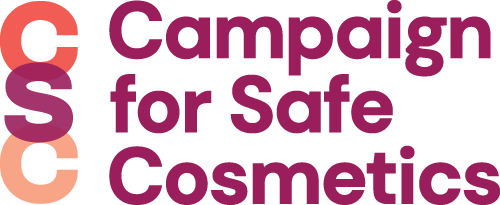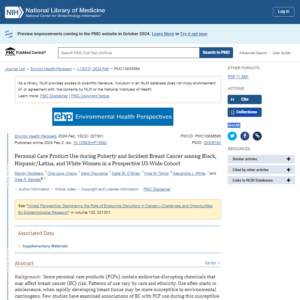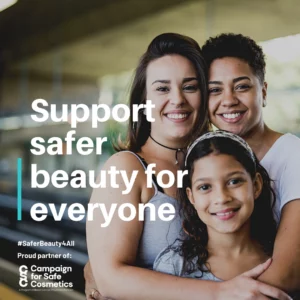For Immediate Release: Monday, December 22, 2014
After defending its use of carcinogens, Revlon reformulates to stake a claim in the growing safe cosmetics market
SAN FRANCISCO – Revlon just got a makeover. Cosmetics giant Revlon has overhauled its ingredients list, vowing to eliminate some of the most toxic cosmetic chemicals from its makeup, mascaras and shampoos. Growing consumer demand for cosmetics free of dangerous chemicals has transformed Revlon from one of the industry’s laggards to a safe cosmetics leader.
“Revlon, the cosmetic industry’s biggest nay-sayer finally heard the safe cosmetics message, thanks to millions of women who believe chemicals linked to cancer and birth defects in their cosmetics and personal care products is too high a price to pay for beauty,” said Janet Nudelman, director of the Campaign for Safe Cosmetics and director of Program and policy for the Breast Cancer Fund. “Revlon’s sweeping announcement raises the bar for the rest of the cosmetics industry and we’re hoping the other cosmetics giants will follow their lead.”
“Women shouldn’t be exposed to cancer-causing chemicals when they apply their makeup,” said Shaunna Thomas, co-founder of UltraViolet. “Young women are developing cancer in record numbers, and we are glad that Revlon finally agreed to listen to its consumers and stop making products with toxic chemicals. By taking a stand and dropping toxic chemicals from their products, Revlon is making clear what we all believe: that no one should increase their exposure to carcinogens from using makeup or other beauty products.”
“Last year when the Campaign for Safe Cosmetics and UltraViolet told Revlon to eliminate toxic chemicals from its cosmetics, the company threatened to sue us for ‘falsely’ accusing it of manufacturing products with cancer-causing chemicals. The company’s about face is deeply satisfying and demonstrates the strength of this David and Goliath movement for safe cosmetics. According to Revlon’s website, the company has stripped some of the most toxic chemicals from its product lines, including a number of carcinogens: cocamide DEA, styrene and two formaldehyde releasing chemicals — DMDM Hydantoin and Quarternium 15,” said Nudelman.
Revlon is taking an important step in the right direction by developing – and publicly disclosing — a comprehensive restricted chemicals list that commits the company to eliminate or never use a laundry list of the worst toxic chemicals found in cosmetics: BHA, long-chain parabens, toluene, triclosan, hydroquinone, phthalates, styrene, two formaldehyde-releasing chemicals, cocamide DEA and polytetrafluoro-ethylene (PTFE).
Talc used in their cosmetics must be certified to be asbestos-free. Revlon also stated they are not using microbeads, which contribute to plastic pollution in waterways and oceans and will label the presence of 26 fragrance allergens, a regulation already in place in the European Union.
However on its newly-rebranded website, Revlon defends its continued use of other chemicals that concern the Campaign for Safe Cosmetics, including sodium laureth sulfate, which may be contaminated with carcinogenic 1,4-dioxane and ethylene oxide. Revlon will also continue to use octinoxate and oxybenzone in sunscreens, despite concerns that these chemicals disrupt normal hormone function; titanium dioxide, which is carcinogenic in its inhalable form; carbon black (classified as a possible carcinogen); polyacrylamide (which can be contaminated with acrylamide, a mammary carcinogen), petrolatum (which may be contaminated with PAHs), and fragrance without full disclosure of constituent ingredients.
In October 2013, Revlon’s general counsel sent a cease-and-desist letter to UltraViolet and the Breast Cancer Fund after the groups launched a petition and action alert that mobilized nearly 50,000 people to demand Revlon immediately stop using cancer-causing chemicals in its makeup and hair dye products. The online campaign was part of a national effort launched by the Breast Cancer Fund, the Campaign for Safe Cosmetics and UltraViolet, a national women’s advocacy organization.
Cancer-causing chemicals are frequently present in cosmetics, which led the Campaign for Safe Cosmetics to launch its “Cosmetics Without Cancer” campaign earlier this year. Even low levels of cancer chemicals can add up to real harm when they are found in multiple products she uses every day, such as shampoos and other hair products, creams, eye shadows, blushes, and nail polish. Procter & Gamble and L’Oreal have been targeted by the Campaign.
# # # #
The Campaign for Safe Cosmetics is a national coalition working to make personal care products safe for people and the planet. Find out more at: https://www.safecosmetics.org
The Breast Cancer Fund is the leading national organization working to prevent breast cancer by eliminating our exposures to toxic chemicals and radiation linked to the disease. Find out more at:http://www.breastcancerfund.org
UltraViolet is an online community of over 500,000 women and men who want to take collective action to expose and fight sexism in the public sector, private sector and the media. Find out more at: http://www.weareultraviolet.org















